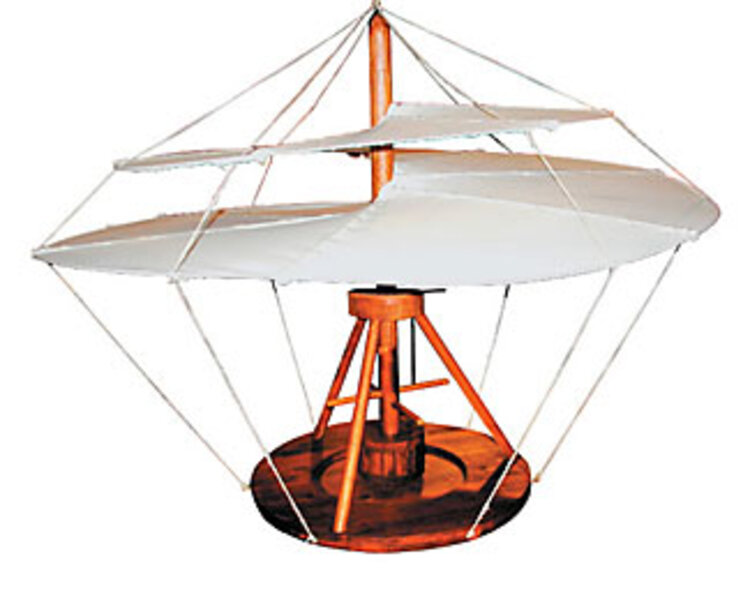Museums push to decode Leonardo da Vinci
Loading...
| San Diego
The San Diego Air & Space Museum, normally devoted to airplanes and astronauts, is offering some unusual items in its gift shop this winter. Browsers can buy "Last Supper" after-dinner mints, make-it-yourself miniature catapults, and Leonardo da Vinci action figures complete with tiny easels.
None of this kitsch has much to do with flight, but Leonardo himself does. He imagined the parachute, glider, and helicopter, along with a fantastic array of machines, weapons, and tools. A new exhibit here is showcasing dozens of full-sized replicas of his contraptions, from the bicycle to the life preserver to, yes, a catapult.
Science museums in Birmingham, Ala., and Portland, Ore., are offering similar exhibits. Meanwhile, a collection of rare drawings by Leonardo finished a US tour earlier this year after leaving Italy for the first time.
Nearly five centuries after his death – and six years after "The Da Vinci Code" hit bookstore shelves (and later, theaters) – the original Renaissance Man has become a major draw for science, flight, and art museums, even though it's difficult, if not impossible, to display his original works.
"He's an accessible person. You can see what he accomplished, and see that he had no advantage to help him accomplish any of that," says Godfrey Harris, curator of "The Da Vinci Experience" exhibit, now in San Diego. The exhibit has drawn a quarter-million visitors to several venues in the West.
Leonardo certainly qualifies as remarkable. Perhaps the most brilliant man in history, he managed to be a writer, scientist, inventor, painter, sculptor, musician, archi- tect, and more.
But which Leonardo should museums depict: the secretive master of deception portrayed in Dan Brown's ultrabestselling novel or the less sensational real-life version?
The museums have chosen the latter, although they're clearly influenced by the thriller. Both the "Experience" exhibit and the "Da Vinci: The Genius" exhibit, now visiting Portland, were created after the book became a sensation. In a nod to the novel, the "Genius" exhibit promises to expose the "secrets" of the "Mona Lisa" by allowing museum patrons to look at giant photographic reproductions of the painting.
"This is all 'Da Vinci Code' hyperbole and fantasy," says Michael Gaudio, an art history professor at the University of Minnesota. "I suppose that's a way to bring in people to exhibitions. But by blowing up the 'Mona Lisa' a bunch of times, you aren't going to discover anything that people haven't already seen by looking at the painting itself."
Even so, there are still plenty of reasons to be fascinated by Leonardo, Mr. Gaudio says. Part of his appeal lies in "the idea of somebody who bridges different areas of inquiry that we tend to separate. Here's somebody who's both an artist and a scientist. For us, those are categories of knowledge, ways of thinking and knowing, that exist for the most part in separate realms. For him, that distinction didn't mean anything. It wasn't even conceivable for him."
Not everyone is a fan of the high-profile "Genius" exhibit. The San Francisco Chronicle, for one, called it "dreary" and complained about unimpressive painting reproductions and $19.50 ticket prices. The San Diego "Experience" exhibit costs even more at $24.75.
The prices may seem high for exhibits that don't include anything that Leonardo touched. Then again, little of his work remains.
Only a few paintings attributed to him are still in existence, and experts disagree over whether they're all authentic. The Portland museum did try to borrow the so-called Codex Leicester, a journal of Leonardo's now owned by billionaire Bill Gates, but the timing made a loan impossible, says museum educator Kate O'Neil.
"That's the challenging part of these exhibits," she says. "How do you re-create this genius without having the actual artifacts and still give people the sense that what they're seeing has authenticity?"
To bring Leonardo to life, the makers of the current exhibits have created replicas of his inventions, including some of those he designed only on paper.
Leonardo didn't make things easy, however. "If he thought of a spring or a hinge, he would then make 30, 40, 50 sketches with new ideas of how it would be configured," curator Mr. Harris says. "One of the challenges is choosing one of the many sketches to replicate for the public what in fact he was thinking about."
Leonardo also often left out details in his designs so that they couldn't be easily copied, Harris says.
So Leonardo may have had a few secrets after all. But those who seek hidden surprises in paintings will be disappointed, art professor Gaudio says.
"He's somebody whose work is really about revealing the secrets of nature, not using his art to make things hard to find."





